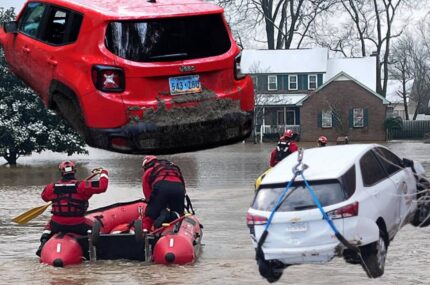A wave of deadly storms and torrential rainfall has wreaked havoc across the southeastern United States, with Kentucky emerging as the hardest-hit state. At least eight people have died in the Bluegrass State of US, where relentless flooding submerged roads, swept away vehicles, and forced hundreds of emergency rescues.
Among the victims were a mother and her 7-year-old child who were tragically carried away by raging floodwaters in Hart County. In Clay County, a 73-year-old man was found dead, highlighting the widespread peril faced by residents. Governor Andy Beshear called it “one of the most serious weather events in at least a decade,” urging people to stay off the roads and remain vigilant. Over the weekend, emergency responders conducted more than 1,000 rescues, as fast-rising waters stranded people in homes and vehicles.
In response to the escalating crisis, US President, Donald Trump approved a federal disaster declaration, enabling the Federal Emergency Management Agency (FEMA) to deploy assistance to affected areas. Meanwhile, around 39,000 homes in Kentucky remain without power, and authorities fear the death toll may rise as rescue operations continue.
Atlanta Fatality as Storms Extend Devastation Across the Region
The extreme weather was not confined to Kentucky alone. In Atlanta, Georgia, a man was killed when a massive tree, uprooted by the storm, crashed through his home. Firefighters rushed to the scene, but the victim succumbed to his injuries, bringing the total storm-related fatalities to at least nine.
Officials have warned that more lives could be at risk as the storm system continues to unleash destruction across the southeastern states of US. In Tennessee’s Obion County, a levee failure triggered flash floods in the small town of Rives, prompting a mandatory evacuation order. Mayor Steve Carr declared a state of emergency, citing “rising water, no electricity, and freezing temperatures” as life-threatening conditions.
In Alabama of US, an EF-1 tornado touched down overnight, damaging mobile homes and toppling trees and power lines. Fortunately, no injuries were reported. Meanwhile, West Virginia has placed 13 counties under a state of emergency as heavy rainfall inundates communities, cutting off traffic and overwhelming emergency responders.
Widespread Power Outages and Infrastructure Collapse across southeastern states of US
Beyond the tragic loss of life, the storms have inflicted severe damage on critical infrastructure. Power outages continue to plague multiple states, with more than 500,000 households left in the dark on Sunday night, according to PowerOutage.us.
In Kentucky alone, over 300 road closures have been reported, making it difficult for emergency services to reach stranded residents. The rapid rise of river levels has submerged entire neighborhoods, with social media images showing vehicles submerged in floodwaters and rescue boats navigating through what were once streets.
Governor Beshear emphasized the long road to recovery, stating, “This is the search and rescue phase, but soon we will be in the rebuilding phase, and it’s going to take significant effort and federal support.” The National Weather Service (NWS) has warned that rivers in Kentucky and Tennessee may continue to rise in the coming days, exacerbating the flooding crisis.
US Federal and State Response to the Disaster
With multiple states grappling with the aftermath of the storm, the US federal government has pledged resources to aid recovery efforts. US President, Donald Trump’s approval of a disaster relief declaration paves the way for FEMA to coordinate emergency response operations. However, the agency’s capacity has been questioned, given past criticisms of its response times and resource allocation.
Kristi Noem, head of the Department of Homeland Security (DHS), confirmed that she had reached out to several state governors, including Beshear of Kentucky and Morrisey of West Virginia. “While emergency management is best led by local authorities, we reinforced that DHS stands ready to take immediate action to offer resources and support,” she said.
Local emergency responders are working tirelessly to mitigate the crisis. In Obion County, Tennessee, rescue teams deployed boats to evacuate residents after the levee break, while in West Virginia, firefighters waded through floodwaters to reach those in distress. Officials continue to urge residents to follow evacuation orders and avoid flooded areas to prevent further casualties.
More Severe Weather Expected in US as Polar Vortex Approaches
As floodwaters continue to rise, meteorologists have issued further warnings about incoming extreme weather. A powerful polar vortex is expected to descend upon the northern Rocky Mountains and the northern Plains, bringing dangerously low temperatures.
In Colorado, temperatures are predicted to drop to as low as -10°C (14°F), and the city of Denver has opened emergency shelters for the homeless. Minnesota is also bracing for severe winter conditions, with wind chills expected to plummet to -50°F.
Bob Oravec, a senior forecaster with the NWS, cautioned that while the worst of the flooding may subside in some areas, the long-term impact of these storms will persist. “The effects will continue for a while—lots of swollen streams, rising rivers, and extensive flooding,” he said.
With emergency crews still conducting search-and-rescue operations, the full extent of the disaster remains unclear. However, one thing is certain: for the communities devastated by these storms, the road to recovery will be long and arduous. Authorities are urging residents to remain vigilant and prepare for potential future storms as extreme weather continues to batter the region














